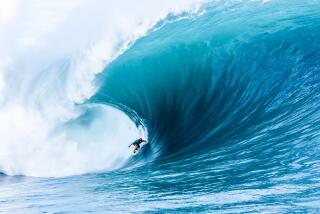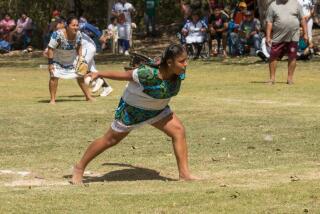Stern Test of Seawomanship : Yachting: All-female crew, half from O.C., sets sail today in grueling Transpac race to Hawaii.
- Share via
Betsy Crowfoot vowed that she would never sail again. Not after a yacht race like that. Waves the size of three-story buildings. Seas churning like a washing machine gone berserk. Loss of power, radar and lights. Forget sailing, Crowfoot said. I’m taking up sky-diving.
Her crew mates could relate. They, too, had been told that the Oakland-to-Catalina yacht race last July would be nothing more than a yawn: gentle breezes, lazy currents, a pleasure cruise. No one envisioned the raging storm ahead. No one aboard the 40-foot sloop, Antara, expected to be worried about survival.
That was a year ago. Today, the core of that crew--Crowfoot of Tustin included--is taking on a greater challenge: the 37th Transpacific Yacht Race from Southern California to Honolulu.
Eight women--four from Orange County, including skipper Bonnie Gibson of Costa Mesa--will sail at 1 p.m. from Point Fermin, just north of Los Angeles Harbor. They hope to cross the finish line 2,225 nautical miles away in 12 to 14 days.
A fast finish is not the ultimate goal, they say. It’s the adventure that drives them. It’s the thrill of taking on the sea, bad weather and all. Inspiration, liberation, self-esteem and camaraderie--they’ll find it, they say, in the middle of nowhere.
While being only the second all-women crew in the race’s history, and the first in 14 years, is important to them, most say they don’t want to make too much of it. But they do hope that their participation will inspire other women in what has traditionally been a male-dominated sport.
“It’s a very physical race,” said Leon Cooper, commodore of the Transpac Yacht Club, which stages the event. “When a man is over 40 or in his 50s, it’s really too much. But women know how to pace themselves better. There’s no reason why they shouldn’t do it.”
Antara’s crew members know it won’t be easy; they learned that last July. Although they have come a long way since the Oakland-to-Catalina venture--one in which they were blown about 80 miles off course--they are in no way complacent.
Last week Terry Monson of Diamond Bar made certain that her life insurance was paid, then withdrew all the money in her bank account and gave it to her mother.
“I wanted to make sure I arranged my affairs,” Monson said.
As the Antara crew knows, ocean racing can be treacherous, exhausting and humbling. People fall overboard when they least expect it. Equipment fails. The wind, reliable one minute, suddenly says hasta la vista.
More predictable, of course, are sunburn, seasickness (the norm for the first few days) and what some sailors refer to as “boat butt” (sort of an adult version of diaper rash).
Dampness permeates all.
“When you’re wet for any length of time,” Monson said, “you basically start to mold.”
Add to that saltwater showers, little or no privacy and a round-the-clock watch system--four hours on, four hours off--and it’s easy to understand why Transpac participants might want to reach Hawaii as fast as nautically possible.
In 1979, Concubine--skippered by 21-year-old Terri Clapp--sailed into Honolulu after 16 1/2 days with an all-woman crew. Winds had been nearly nonexistent. The weather was hot, the Concubine crew edgy. A problem with the boat’s freshwater supply led to rationing, meaning freeze-dried meals had to be prepared with seawater.
Jolly sailors, they were not.
Antara owner Barry Schuyler, a retired UC Santa Barbara professor and women’s sailing advocate, watched the Concubine pull into Honolulu that year. He heard about the disharmony among its crew. Fourteen years later, the women racing his boat to Hawaii are focusing on group dynamics as much as anything else.
They talk about interfacing and team building. They underwent personality profile tests. During the Transpac, group communication sessions will be scheduled daily to help solve any interpersonal conflicts.
Call it the New Age Antara.
Deb Rigas, Antara’s navigator, probably would. She’s the one with the sapphire-studded nose ring. She’s the one who hoped to bring a big cowhide-covered drum so she could sit on the deck and bang out a rhythmic beat.
“So I could tune in to that earthy, vibe thing,” said Rigas, 38.
The drum is too big, so she will have to be content with yoga and aerobics. Born in Japan, raised in Europe, Rigas is the daughter of a former U.S. Army entertainer. She made her professional debut at 6, shaking maracas in a German nightclub. A licensed midwife, she lives in a Seattle suburb, where she meditates in a garden filled with irises, roses and wind chimes.
Her ultimate goal, she said, is “to sail a beautiful, mystical sailboat around the world, deliver babies and write cross-cultural stories and stuff.”
“I’m a dreamer with a warrior soul,” she said.
Crowfoot of Tustin helped compile the provisions. She’s also in charge of morale. She organized several theme parties for the voyage--a Broadway-type production, a Sunday brunch, a hot dog roast (complete with sparklers) on the Fourth of July.
Huntington Beach resident Flora Obayashi, 42, grew up on a cattle ranch on the Hawaiian island of Molokai. Only 200 lived in her hometown, Pukoo, and the nearest neighbor was three miles away. Kids went to school barefoot, some on horseback.
After moving to Honolulu, she went down to the harbor every July to watch the finish of the Transpac. Some day, Obayashi told herself, I’ll be on one of those crews, too.
At 27, Lori Barnes of Fountain Valley is the youngest crew member. Like Amanda Russell--a 28-year-old Briton who recently moved from Huntington Beach to San Francisco--and alternate Judy Rudner, 27, of Cypress, Barnes sees Transpac ’93 as a steppingstone. Some day, Barnes says, she would love to sail around the world solo.
The skipper, Gibson, is 45, works as a dental hygienist, owns an embroidery business, serves as president of the Orange County-based Women’s Ocean Racing Sailing Assn. and, in the past few weeks, has averaged only two to three hours sleep each night.
In December, 1991, Gibson was found to have cervical cancer. She underwent two surgeries, the second last August. She was sailing again by September.
Said Gibson: “Women learn in sailing about their own personal strengths.”
First mate Shirley Doell agrees. Two years ago, Doell, a 37-year-old crew coach at UC San Diego, was sailing her father’s boat from England to the Canary Islands. Off the coast of Portugal, a storm hit in the middle of the night. Winds whipped in at 60 knots. Doell’s two crew mates were seasick and weak. Even though the boat was knocked over twice, Doell managed to make all the emergency repairs and sailed into the closest port.
It is experiences such as these that make women’s sailing advocates wonder. How is it that, after proving themselves repeatedly in difficult situations, women are still generally viewed as second-class sailors? Though several managed to earn respect--the late Peggy Slater, who skippered L’Apache in the Transpac in 1951, was considered a pioneer--the majority of women who have participated in Transpacs have done so as cooks.
“Sailing is still very, very much a man’s sport,” Antara owner Schuyler says. “Men say you need a lot of strength to handle the sail, but you really don’t if you use your head. . . . It’s more tradition than anything else.”
Which is one reason why the Antara crew is so enthusiastic about this year’s Transpac. Some, such as Obayashi, hope the experience will help them put together a future campaign of their own.
Today, though, the Antara crew would just like to savor the moment. The past year required many sacrifices. One crew member’s boyfriend of more than a decade told her he would leave her if she took on such a commitment. A few won’t have a job to come back to when they return.
But, they say, the good definitely outweighed the bad.
In the last two weeks, product donations have poured in. The crew will be outfitted in boat shoes, bathing suits, jackets, T-shirts, gloves and hats. A surf shop in Newport Beach donated sunscreen. The Sea Gals of the Balboa Yacht Club prepared seven days’ worth of dinner entrees. A woman in Oakland gave them a quilt.
From countless rolls of film to the latest in safety equipment to dry ice, the crew received nearly $20,000 in freebies. Not bad for a grass-roots project, as Antara supporters like to call it.
Not bad for a boat which a year ago this Monday was being towed into Port San Luis Obispo by the Coast Guard.
Crowfoot--who, according to husband Jim was so exhausted and distraught after the Oakland-to-Catalina race last year that she stayed in bed for three days--says the crew of the Antara is better off having gone through that storm.
“We learned a lot from that race,” Crowfoot said. “Mostly that you have to be prepared, and you can’t rely on what people tell you.”
Crowfoot paused a moment. She laughed, then added:
“We’ll be OK. Fear is the greatest motivator.”
More to Read
Sign up for The Wild
We’ll help you find the best places to hike, bike and run, as well as the perfect silent spots for meditation and yoga.
You may occasionally receive promotional content from the Los Angeles Times.






